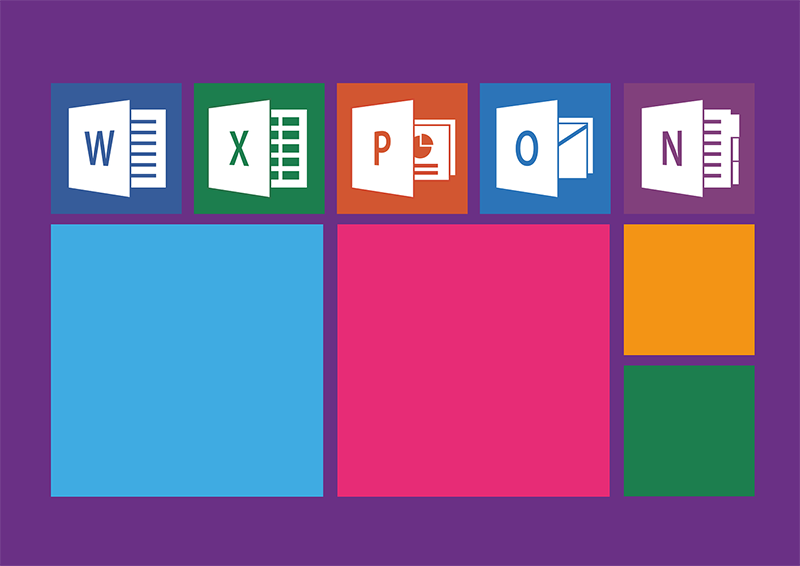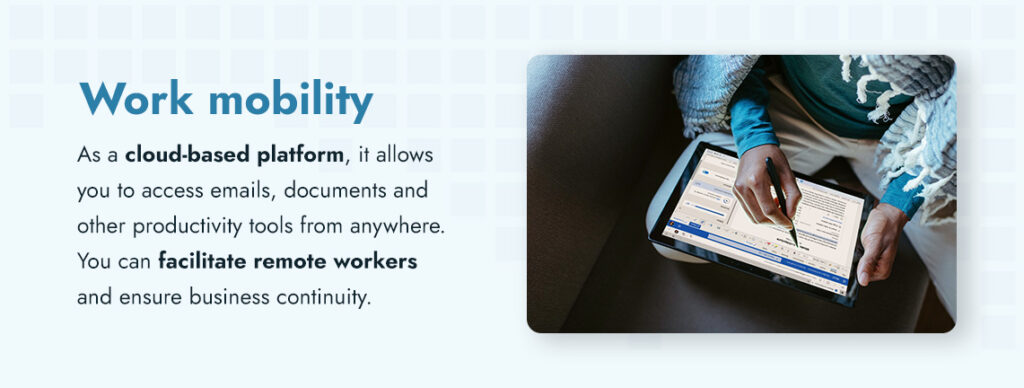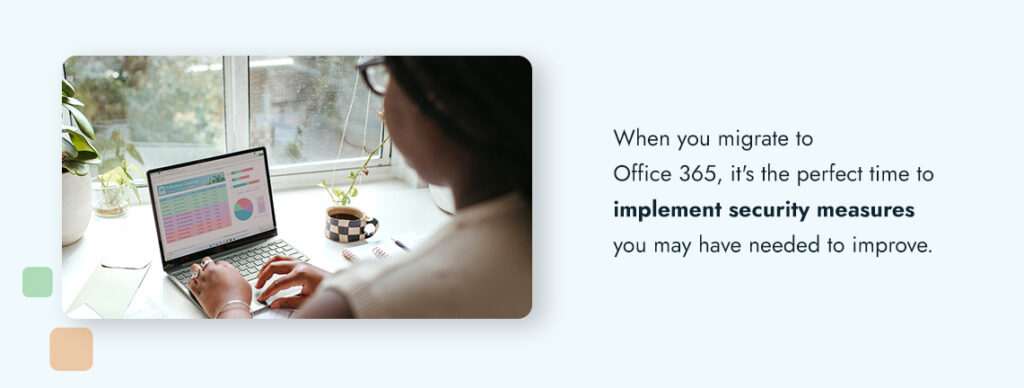
Microsoft365 Migration Guide: The Do’s and Don’ts
If you’re planning a migration of Office 365, it’s a big step for your business. Part of a successful migration is thorough planning. You need to understand your business needs and choose a plan best suited to the environment. With meticulous planning, you can avoid mistakes along the way.
Wondering how to prepare for Microsoft 365 migration? Our guide has essential dos and don’ts to help you prepare for a more efficient and streamlined process.
What Does It Mean to Migrate to Office 365?
Office 365 offers businesses a highly scalable solution, allowing you to add or remove user licenses as your business changes. It is a cloud-based platform that enables users to access emails, calendars and other applications from anywhere, provided they have an internet connection. Here’s what you’ll get when you migrate to Office 365:
- Improved security: Office 365 takes security off your hands as Microsoft handles all the platform’s compliance, privacy and security. It offers robust security features such as threat intelligence, data loss prevention, multi-factor authentication and threat intelligence.
- Work mobility: As a cloud-based platform, it allows you to access emails, documents and other productivity tools from anywhere. You can facilitate remote workers and ensure business continuity.
- Disaster recovery: In a catastrophe such as a hardware failure or a natural disaster, disaster recovery allows you to access your information because it is stored on the cloud.
- Cost savings: When you migrate to Office 365, you pay a subscription, which can be more cost-effective than maintaining on-premise Exchange servers. You can avoid investing in hardware and software and better predict your IT costs.
- Integrated productivity tools: Office 365 gives you access to productivity tools such as Word, Excel, PowerPoint, Teams and more. These tools help you to facilitate seamless collaboration in your organization.
What to Do When Migrating to Office 365
Migrating to Office 365 has many benefits, but the process can be complex. When migrations aren’t done well, they can cause work systems to go down. We’ve put together a list of our top do’s to equip you for a seamless transition.

Plan for the Migration
Once your data and accounts have synced to Office 365, you can pick a date to begin using the new program officially. Give your employees several weeks to get used to Office 365 before the cutover date. IT will need to be on call to provide support and answer your employees’ questions or concerns.
Plan For Co-Existence
Migrations typically take weeks or months — while it’s happening, you need to ensure that your teams stay productive throughout the project. For example, during migration from on-premise Exchange to online Exchange, users need to be able to schedule meetings even though half of them have migrated and the others have not. The collaboration should be seamless if you use a tool with robust co-existence capabilities. If not, users will hit roadblocks.
Minimize the Impact on Business
Seamless co-existence is one of the factors that affect migration’s impact on your business, but it is by no means the only one. The goal is to keep the migration from becoming a major event and disrupting business operations. This includes ensuring that it is complete and accurate as quickly as possible and keeping management updated with the progress.
Implement the ABCs of Security
When you migrate to Office 365, it’s the perfect time to implement security measures you may have needed to improve. The ABCs of security are audit, backup and control and they can make a big difference in making your new Office 365 environment secure.

Pick the Right Plan
Office 365 offers different subscription plans with various applications such as Word, Excel, Outlook and other productivity services. Ensure you take stock of your business needs and understand your business environment to choose the right Microsoft 365 plan. Some plans may include free features such as email encryption, while others will require you to pay.
Depending on your business type, you may also need to purchase special licensing. If you need assistance picking the right plan, a managed service provider (MSP) can advise you on which products best fit your business needs.
Use Software to Sync Accounts and Data
The easiest way to migrate to Office 365 is to use software that supports this transition. For example, Exchange is a Microsoft product tailored to store emails in a centralized place while switching to Office 365. It can help speed up the migration process. IT professionals can also use it to locate company-relevant mailboxes to sync all emails and passwords into the new program.
What You Shouldn’t Do When Migrating to Office 365
Unfortunately, the migration goes wrong for some businesses, leaving them locked out of business-critical applications. You should avoid these common mistakes to avoid Office 365 migration issues.
Skimp on Preparation
If you’ve done a migration in the past, then you know how essential it is to prepare. While you are preparing, consider the following questions:
- How much does it cost to perform the migration?
- What are the most complex technological challenges?
- Can emails, messages, whiteboards, etc. migrate with users and data?
- Do you need to dedicate your entire IT team to the migration?
Forget About Post-Migration Management
When you migrate to Office 365, there’ll be a lot less administrative work but you’ll still need to ensure a secure and effective environment. Having job reports to ensure all project parts are visible, accurate and timely. Part of the post-migration process management is ensuring a seamless end user transition.
Leave Migration to the IT Department
Your IT department may lead the migration to Office 365, but if you leave the entire process to them, you’ll encounter roadblocks in adoption and engagement.
Considering the 80/20 rule when migrating to Office 365 is wise — 80% non-IT staff and 20% IT staff. The number of non-IT staff may seem high, but they are essential to give feedback about the platform and guide you in what is needed to support their work.
For example, they can advise IT on what data they need, what they don’t need to be migrated and what apps will enhance workflow. This method gives teams a sense of ownership, making them more likely to buy into the migration.
Not Training Staff Members
Your employees need to know exactly why they are moving to Office 365 and how it benefits them. Give them advice on how to make the most of the features that come with the platform. Busy professionals are unlikely to play around with the features to discover what the platform can do for them. When employees don’t receive training, your company isn’t receiving the full value of its investment and employees aren’t as productive as they would be if they knew how to use all the features.
Rush Data Transfer
When you are migrating, don’t give in to the temptation to rush so you can enjoy the features. Migrating too quickly can result in data loss or the inability to find the content you need. When moving data from your on-location server to Office 365, choose what you would like to move carefully. If you need clarification on some files, check with the relevant department. Take your time to ensure a seamless transition.
Migrate to Office 365 With Contigo Technology

Migrating to Office 365 can transform your business operations. It offers you great flexibility and security and improves efficiency. Transitioning requires careful planning and consideration. Rushing the process can result in a few mishaps along the way. By picking the right plan for your company’s needs and careful preparation, you can have a seamless migration that enhances productivity. Remember that to make the most of your investment, you need buy-in from your employees. Training your staff on using the platform will help them make the most of it.
If you need help determining what plan is best for your business, Contigo Technology is here to help. Our Office 365 migration services are seamless and ensure the best fit for your company. We also provide post-migration support for a seamless transition. Contact us today for a quote!